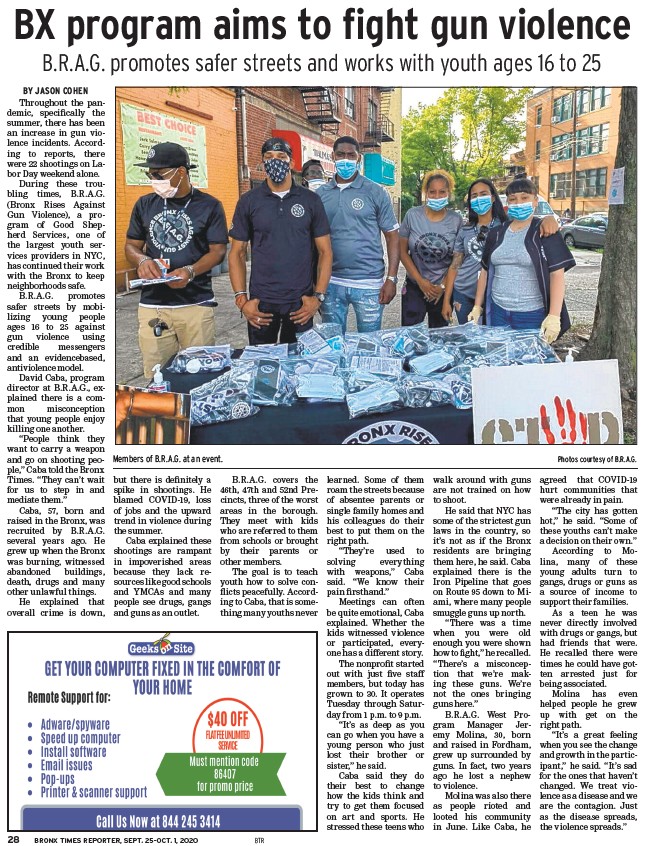
BX program aims to fi ght gun violence
B.R.A.G. promotes safer streets and works with youth ages 16 to 25
BY JASON COHEN
Throughout the pandemic,
specifi cally the
summer, there has been
an increase in gun violence
incidents. According
to reports, there
were 22 shootings on Labor
Day weekend alone.
During these troubling
times, B.R.A.G.
(Bronx Rises Against
Gun Violence), a program
of Good Shepherd
Services, one of
the largest youth services
providers in NYC,
has continued their work
with the Bronx to keep
neighborhoods safe.
B.R.A.G. promotes
safer streets by mobilizing
young people
ages 16 to 25 against
gun violence using
credible messengers
and an evidencebased,
antiviolence model.
David Caba, program
director at B.R.A.G., explained
there is a common
misconception
that young people enjoy
killing one another.
“People think they
want to carry a weapon
and go on shooting people,”
Caba told the Bronx
Times. “They can’t wait
for us to step in and
mediate them.”
Caba, 57, born and
raised in the Bronx, was
recruited by B.R.A.G.
several years ago. He
grew up when the Bronx
was burning, witnessed
abandoned buildings,
death, drugs and many
other unlawful things.
He explained that
overall crime is down,
Members of B.R.A.G. at an event. Photos courtesy of B.R.A.G.
but there is defi nitely a
spike in shootings. He
blamed COVID-19, loss
of jobs and the upward
trend in violence during
the summer.
Caba explained these
shootings are rampant
in impoverished areas
because they lack resources
like good schools
and YMCAs and many
people see drugs, gangs
and guns as an outlet.
B.R.A.G. covers the
46th, 47th and 52nd Precincts,
three of the worst
areas in the borough.
They meet with kids
who are referred to them
from schools or brought
by their parents or
other members.
The goal is to teach
youth how to solve confl
icts peacefully. According
to Caba, that is something
many youths never
BRONX TIMES REPORTER,28 SEPT. 25-OCT. 1, 2020 BTR
learned. Some of them
roam the streets because
of absentee parents or
single family homes and
his colleagues do their
best to put them on the
right path.
“They’re used to
solving everything
with weapons,” Caba
said. “We know their
pain fi rsthand.”
Meetings can often
be quite emotional, Caba
explained. Whether the
kids witnessed violence
or participated, everyone
has a different story.
The nonprofi t started
out with just fi ve staff
members, but today has
grown to 30. It operates
Tuesday through Saturday
from 1 p.m. to 9 p.m.
“It’s as deep as you
can go when you have a
young person who just
lost their brother or
sister,” he said.
Caba said they do
their best to change
how the kids think and
try to get them focused
on art and sports. He
stressed these teens who
walk around with guns
are not trained on how
to shoot.
He said that NYC has
some of the strictest gun
laws in the country, so
it’s not as if the Bronx
residents are bringing
them here, he said. Caba
explained there is the
Iron Pipeline that goes
on Route 95 down to Miami,
where many people
smuggle guns up north.
“There was a time
when you were old
enough you were shown
how to fi ght,” he recalled.
“There’s a misconception
that we’re making
these guns. We’re
not the ones bringing
guns here.”
B.R.A.G. West Program
Manager Jeremy
Molina, 30, born
and raised in Fordham,
grew up surrounded by
guns. In fact, two years
ago he lost a nephew
to violence.
Molina was also there
as people rioted and
looted his community
in June. Like Caba, he
agreed that COVID-19
hurt communities that
were already in pain.
“The city has gotten
hot,” he said. “Some of
these youths can’t make
a decision on their own.”
According to Molina,
many of these
young adults turn to
gangs, drugs or guns as
a source of income to
support their families.
As a teen he was
never directly involved
with drugs or gangs, but
had friends that were.
He recalled there were
times he could have gotten
arrested just for
being associated.
Molina has even
helped people he grew
up with get on the
right path.
“It’s a great feeling
when you see the change
and growth in the participant,”
he said. “It’s sad
for the ones that haven’t
changed. We treat violence
as a disease and we
are the contagion. Just
as the disease spreads,
the violence spreads.”